The 2021/22 campaign was a gruelling and debilitating season for all stakeholders involved in Borussia Mönchengladbach.
The once-great German club finished in the bottom half of the table for the first time since 2011, ending the season with a negative goal difference and a vacant managerial seat.
However, in the darkest of times, only the best shine the brightest.
Among all the roughage of the previous campaign was a diamond in the form of Kouadio Koné.
In January 2021, Mönchengladbach splashed €9 million out on an unpolished 19-year-old stone from Toulouse who was impressing in Ligue 2, although Koné was allowed to remain with Les Violets until the summer.
Upon arrival in North Rhine-Westphalia, Koné quickly became a vital member of a struggling squad, making 29 appearances in total over the course of the season for Mönchengladbach under Adolf Hütter.
The now-21-year-old has made a name for himself for his top performances in white, green and black and has garnered interest from some of Europe’s elite sides, including Manchester United and Juventus, two clubs in need of someone of Koné’s ilk.
This tactical analysis piece will be a scout report of Koné.
It will be an analysis of his strengths and weaknesses, as well as observing his role within Borussia Mönchengladbach’s tactics last season.
Player profile
Midfielders capable of operating as single pivots have become one of the most sought-after commodities in the modern game.
Everyone is on the lookout for players that can execute the same functions as Liverpool midfielder Fabinho and Manchester City’s Rodri, but there are very few on the market for a decent price.
Koné can, and has, been influential as a number ‘6’ for Mönchengladbach this season, although the Frenchman can also play further forward in a more advanced role as an ‘8’ on either side of the midfield.
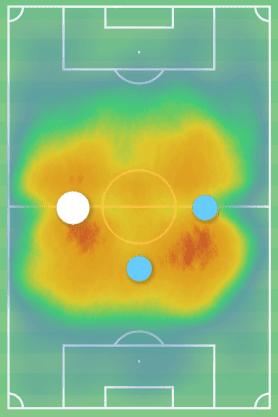
Nevertheless, as can be seen from this graphic from the 2021/22 campaign, Koné’s main position has been on the left side of a midfield trio.
Generally, Hütter would partner Koné with Florian Neuhaus and Jonas Hoffman, or Cristoph Kramer if he was fit.
Mönchengladbach set themselves up in a 3-5-2/5-3-2 for the most part although they were no stranger to the 4-2-3-1 on occasion.
But irrespective of the formation used, their tactics were very fluid, especially in the middle of the park.
The midfielders constantly rotated with each other, popping up into different spaces, particularly in the build-up phase, although this is something which will be analysed in further detail later.
However, it made for a fascinating heatmap from Koné who covered pretty much the entire middle third with his movement.
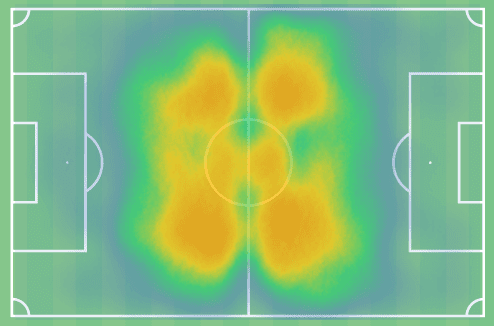
There is a possibility that Koné makes another leap in his career this summer by moving to a bigger club but, should he remain in Mönchengladbach, the 21-year-old will be used in a very similar role under new manager Daniel Farke, formerly of Norwich City.
Farke’s tactical set-up at Carrow Road was possession-heavy, with plenty of rotations in the middle of the park.
Koné could excel under the new boss’ guidance.
Koné stands at an impressive 6ft 1 and weighs 80kg, according to Wyscout.
When seeing this, one may get a false impression that Koné is quite a clunky midfielder, and somewhat lethargic but this isn’t true.
Koné is very nimble, wonderful with the ball at his feet and can play in tight spaces due to his excellent dribbling ability.
The Mönchengladbach star is a very well-rounded right-footer.
Now, let’s take a look at some of his strengths and weaknesses.
Use in the build-up phase
When playing in the holding midfield role, being able to play with your back turned to goal is one of the most vital characteristics of any player.
When a side is playing out from the back, the pivot players need to be comfortable facing their own centre-backs, with pressure likely to be applied from behind them.
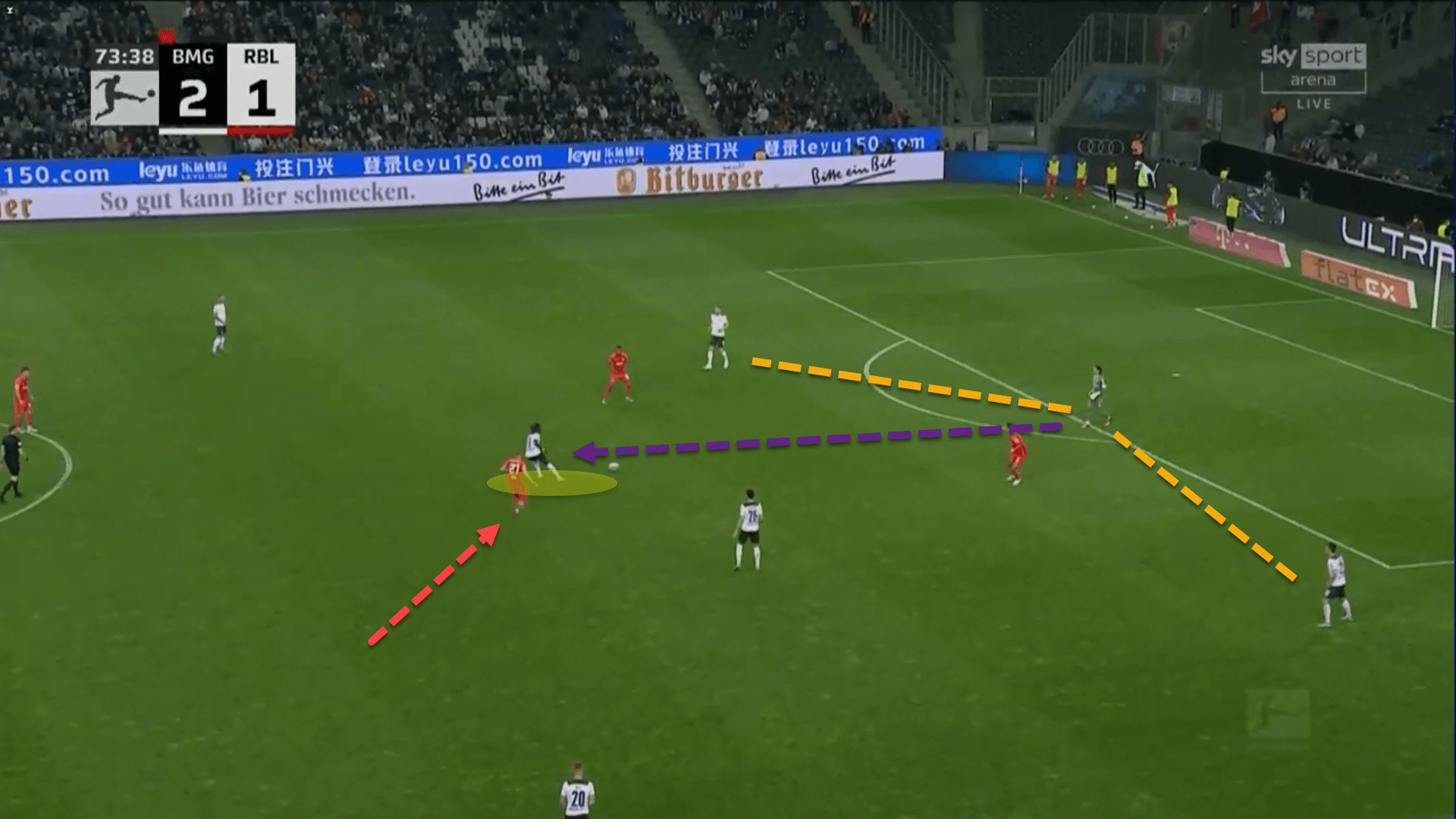
Koné certainly is comfortable playing with his back turned to the opposition’s goal.
Calling him press-resistant would be a step too far given that the midfielder is still prone to a mistake during the build-up phase or a lapse of judgement, but the 21-year-old’s body orientation in these deeper areas is generally always correct.
It’s important for players to play the way they are facing when sitting in the pivot space, behind the opposition’s first line of pressure.
Essentially, this means that the midfielder must have the correct body position in order to shield oncoming pressure, allowing them to play with their preferred foot to the intended pressure.
Koné rarely has incorrect body posture, making him a relatively safe passing option in the build-up phase for circulation and progression.
Quite often, the France U21 international will even orient his body to receive on the half-turn, allowing Mönchengladbach to break through their opponent’s pressure with ease.
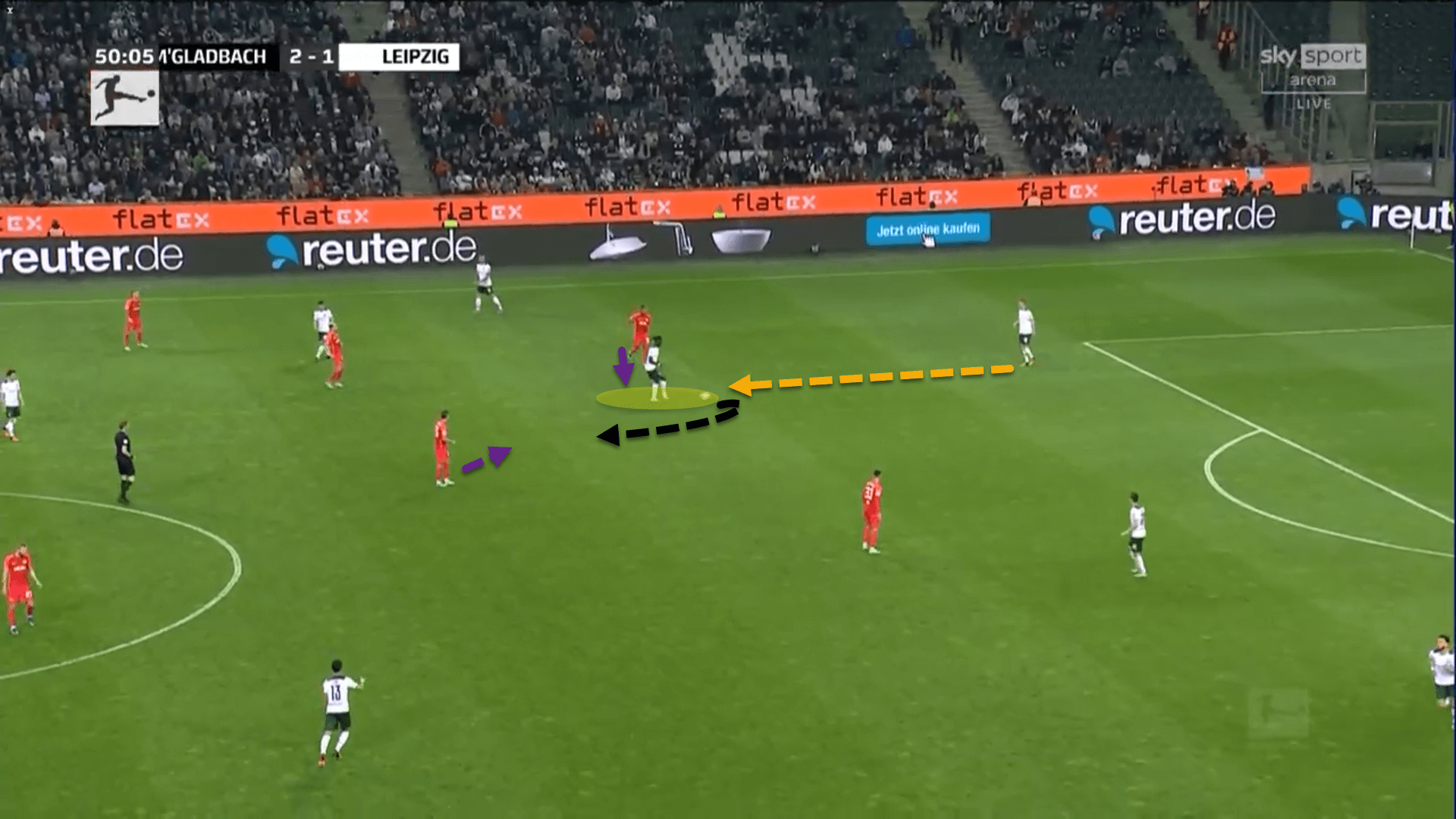
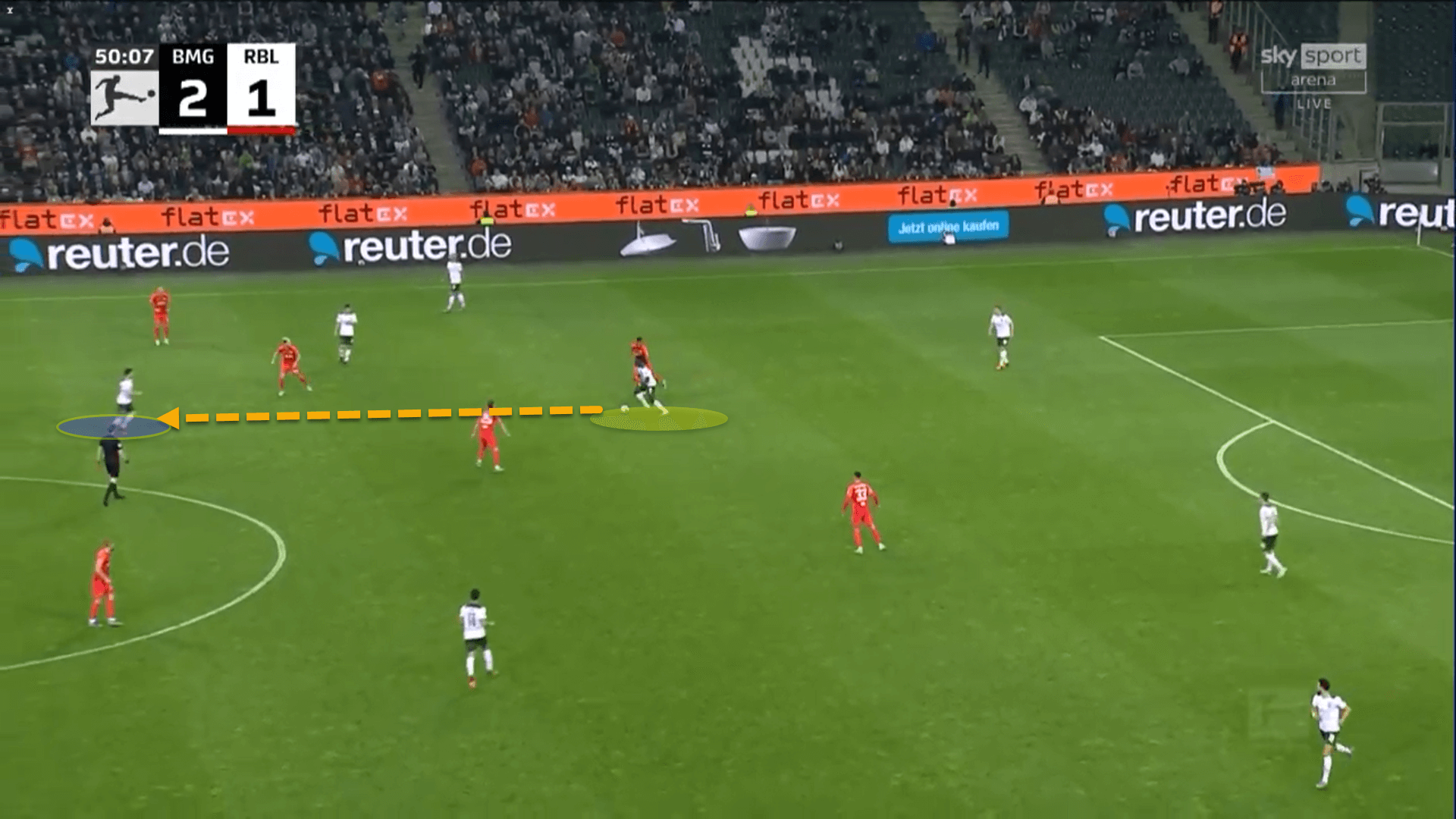
Here, Koné is sitting behind the opponent’s first pressing line and is receiving the ball from Mönchengladbach’s right centre-back.
Having scanned the area around him, analysing how much time and space he had, Koné quickly received the ball on the half-turn, bypassing pressure and playing forward into space.
With Koné, Mönchengladbach are in safe hands on the ball in these deeper areas.
From a total of 49 passes attempted per 90 in the previous campaign, Koné boasted a passing accuracy of 88 percent which was in the 85th percentile of all midfielders in the Bundesliga.
Furthermore, Koné played 4.54 progressive passes per 90 last season as well as 4.70 progressive carries, putting him in the 71st and 73rd percentiles in Germany’s top-flight division.
More impressively, Koné averaged 11.21 passes under pressure per 90 , placing the player in the 93rd percentile.
As spoken about previously, Mönchengladbach were incredibly fluid in possession under Hütter, despite their overall frailties.
In the build-up phase, the midfielders would constantly rotate and move into different spaces to pick up the ball.
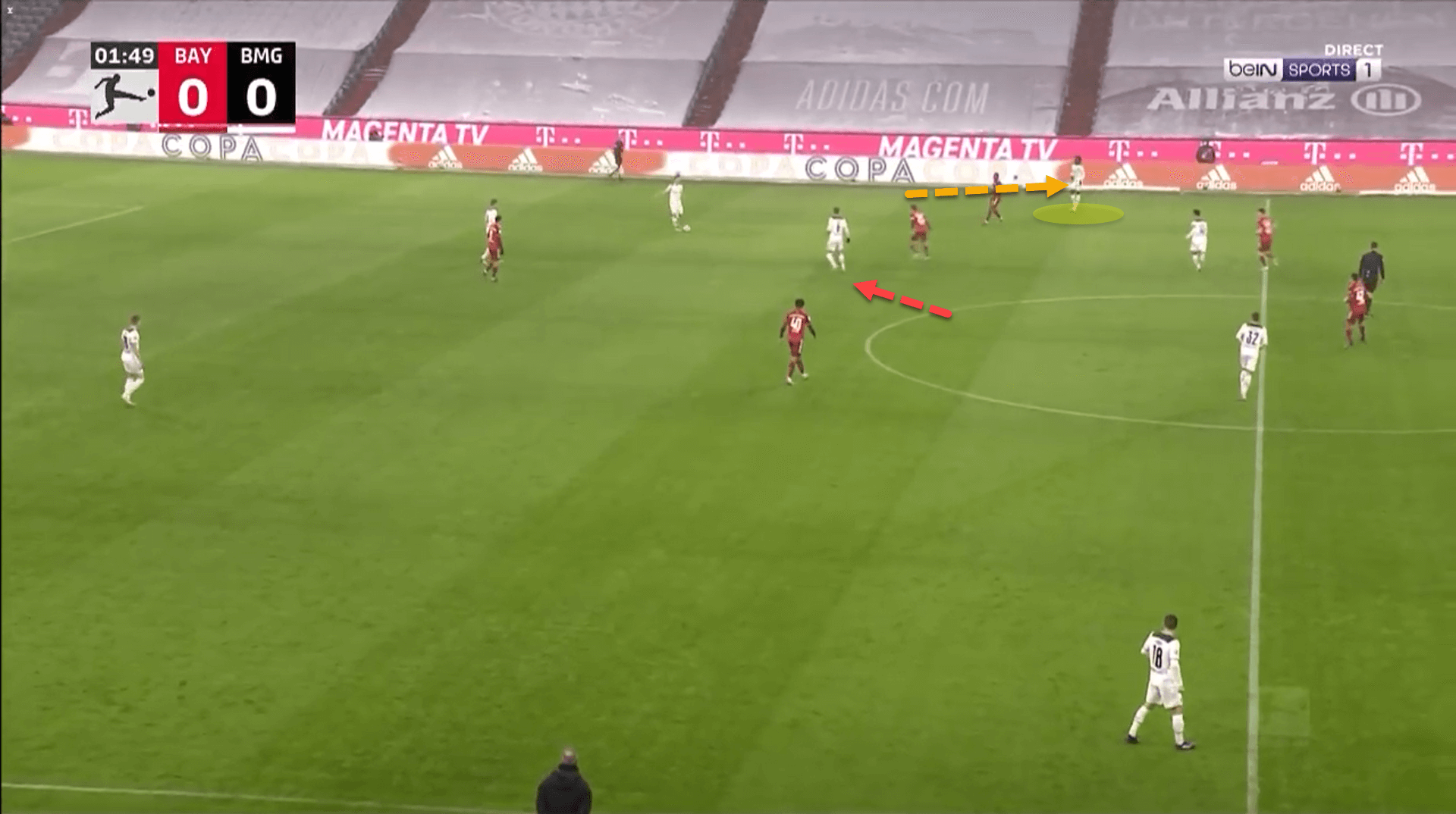
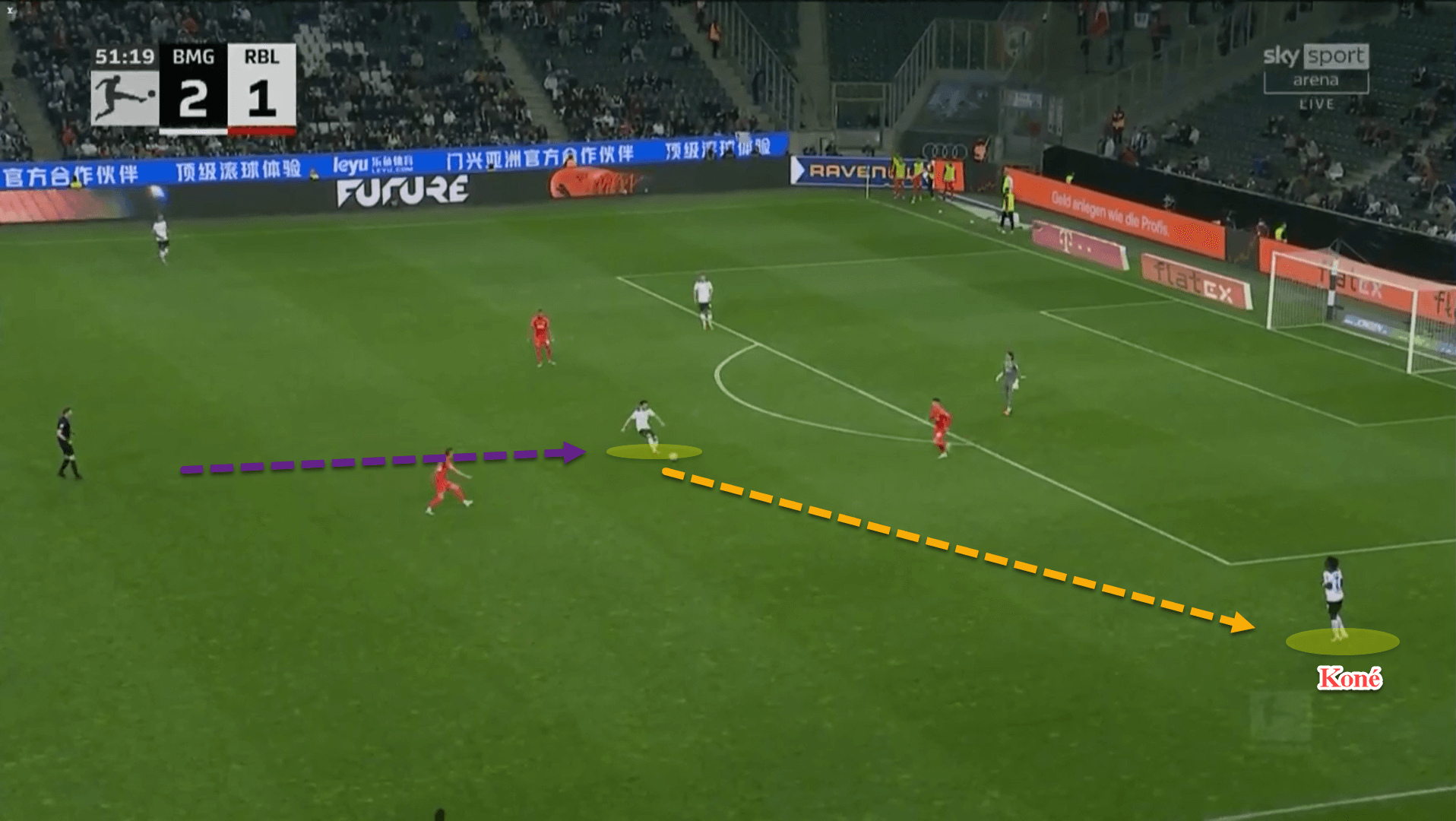
This is one of the reasons why Koné’s heatmap is so dispersed.
The Frenchman pops up all over the pitch when his side are in possession, constantly looking for the ball.
Koné’s archetype is perfect for a side that dominates possession throughout games and could be a very astute acquisition this summer for any team looking for a bit of an all-rounder.
Role out of possession
Not only is Koné adaptable and assured on the ball, but he also makes a great asset out of possession for the Foals.
The midfielder is quick and highly energetic, allowing him to zoom around the pitch, marking different players and attempting to intercept the ball.
Having used a proactive defensive system under Hütter last season, Koné was a wonderful asset in stepping out from the midfield line to apply pressure to a player receiving with their back turned.
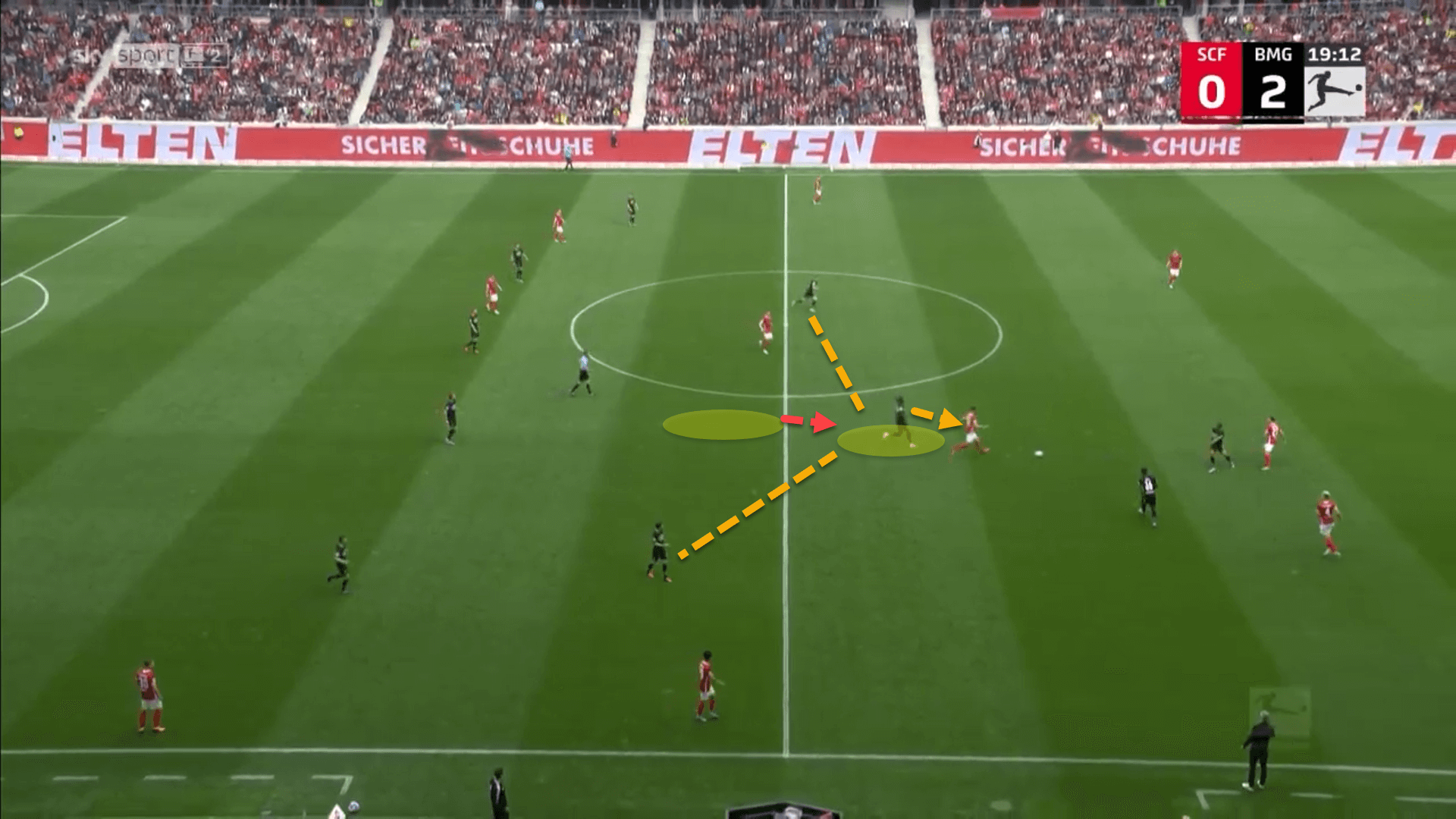
All midfielders want time and space, two of the most integral components for a player in the middle of the park.
Nobody wants someone closing them down and hassling them constantly.
Koné averaged 20.61 pressures per 90 last season in the Bundesliga, putting him in the 70th percentile for all midfielders.
What’s most impressive is that 7.87 of these total pressures were a success, ranking him in the 94th percentile.
Most of these pressures came in the middle third of the pitch – 11.71 of the 20.61 per 90, to be precise.
One key area where Koné needs to improve is being more cautious when stepping out to press, especially when he is the single pivot in the team.
A few times, Koné has been caught out by misjudging his timing and this has allowed the opponent to play into the space behind him.
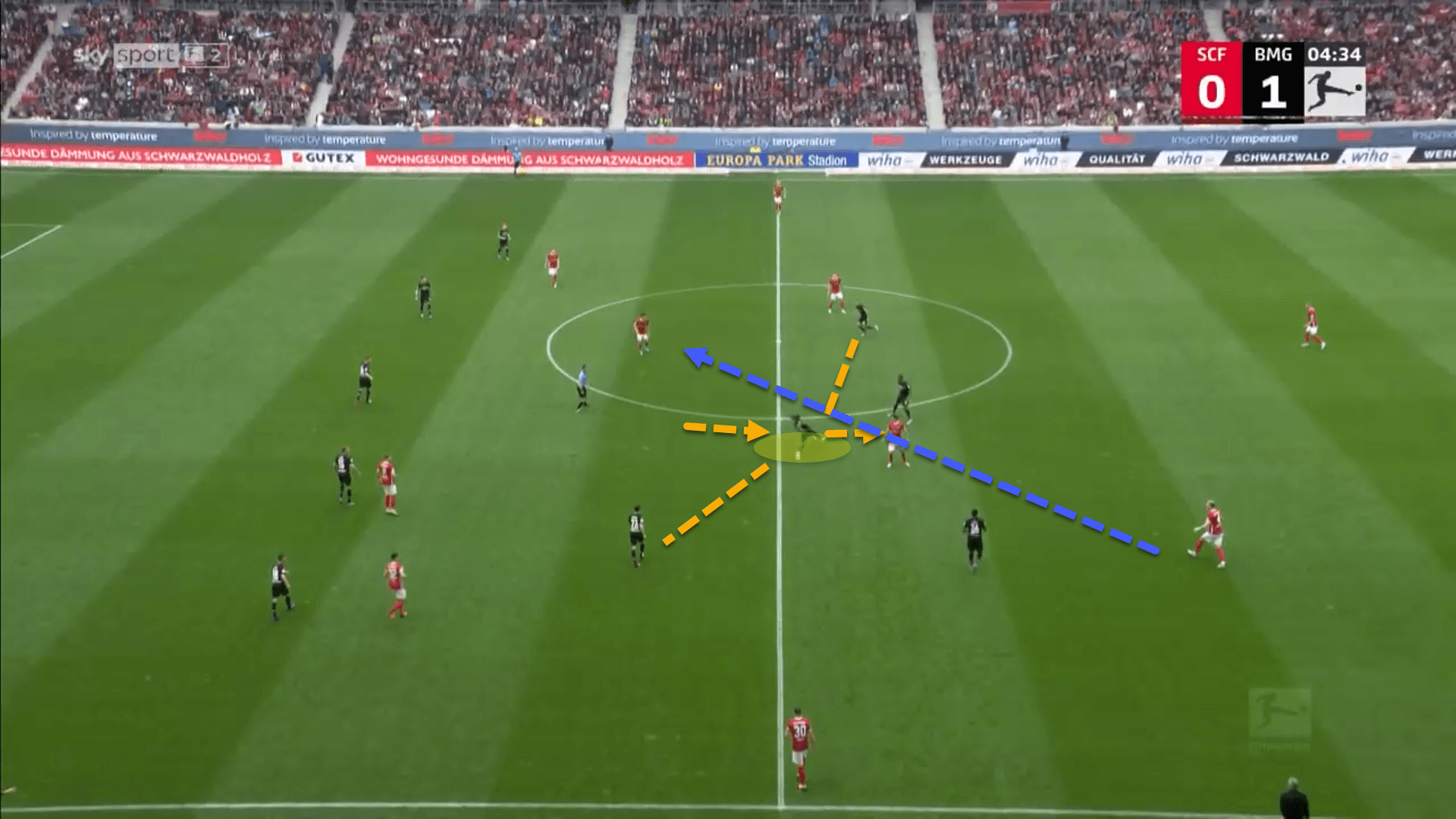
For instance, here, Koné misjudged the distance between himself and the Freiburg player.
Having already darted forward to try and intercept the ball, the opposition centre-back, Nico Schlotterbeck, managed to slip it past him, with the pass finding an attacking player in a dangerous position to turn and drive at the Borussia Mönchengladbach forward line.
He’s still young and mistakes will always happen.
Koné will undoubtedly curtail these errors with more experience.
Trial and error is possibly the best method for growth in relation to timing his pressing better.
However, Koné’s tenacity helps his side quite a lot during counterpressing situations.
He is tireless and closes down incredibly well, making for the perfect player in a team that aggressively counterpresses upon losing possession.
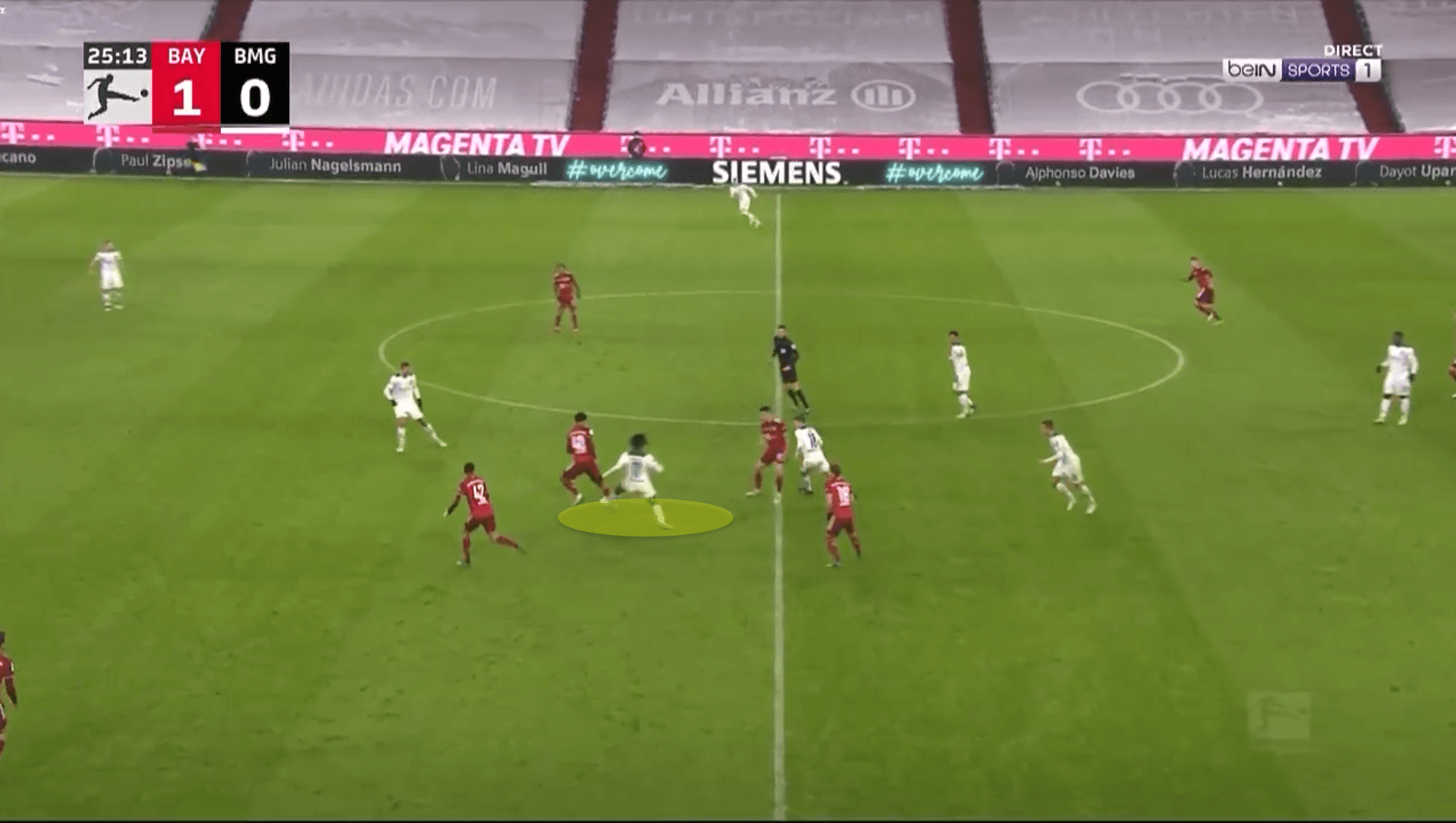
In this example, Bundesliga champions Bayern Munich had forced a turnover of possession.
While counterpressing, Koné sticks his boot out and expertly recovers it, allowing Mönchengladbach to regain the ball.
In the league last season, Koné averaged 2.76 interceptions per 90, as well as 5.57 tackles plus interceptions per 90, putting him in the 92nd percentile which is highly impressive.
Moreover, he won 1.86 tackles per 90.
When Mönchengladbach are sitting in a settled defensive block, and Koné is holding the line to protect the centre-backs, he shows real maturity in his game.
Under Hütter, when Mönchengladbach were sitting in a deeper defensive block, Koné was tasked with playing zonally, picking up any players that dropped into his zone.
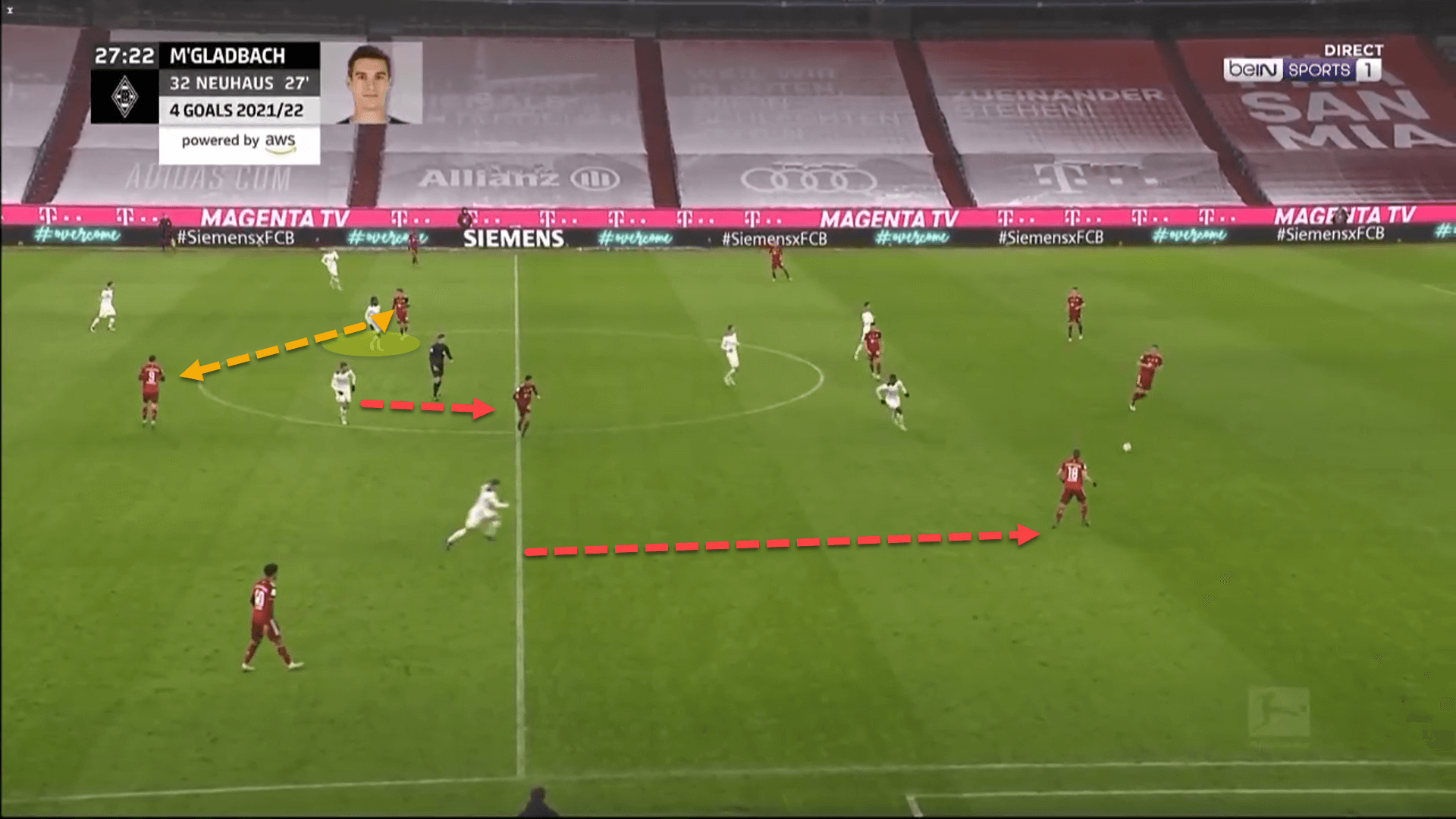
This image is the perfect example of Koné excelling in this role.
He has the tactical and positional intelligence to be aware of his surroundings, constantly scanning to cut off the most dangerous passing option.
In the example above, Koné is standing between Thomas Müller and Robert Lewandowski, two titans of European football.
Having assessed the danger around himself, he shifted across to mark the latter.
Again, Koné is still raw and has some rough areas that need to be smoothed with age and the right coaching, but there is undoubtedly an extremely clever midfielder there who does a very good job at protecting the backline.
Further up the pitch
Effective in the deeper phases of possession and off the ball, Koné still needs to improve quite a lot in his attacking play further up the pitch if he is to play as a sole number ‘6’.
The 21-year-old attempted just 3.55 passes to the final third per 90 and was ranked in merely the 43rd percentile in the Bundesliga.
Even worse than this is that Koné attempted only 0.45 passes into the penalty area, putting him in the 25th percentile for midfielders.
In the opponent’s half of the pitch, Koné has a habit of playing lateral and backward passes unnecessarily.
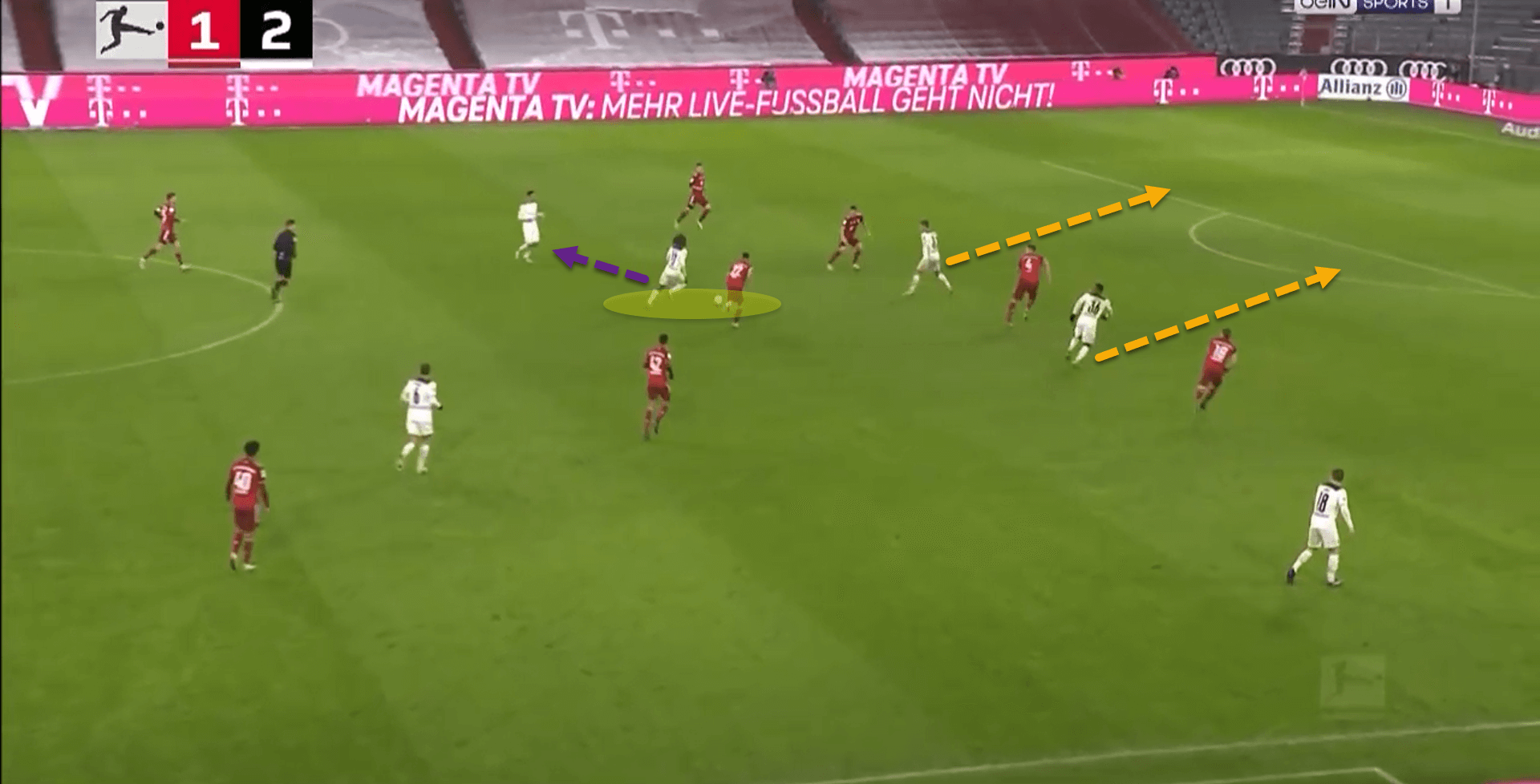
Like in this example.
Koné could have tried to slip in these two runners behind Bayern’s backline, but instead opted for a safer square ball.
The midfielder needs to be more dangerous in possession.
He is a wonderful dribbler and carrier of the ball, ranking in the 98th percentile for dribbles completed by a midfielder.
However, Koné needs to back himself more in the final third to be a real attacking threat for his side.
Too many times, Koné settles for the easy option in the opponent’s half.
While this isn’t necessarily the worst trait in the world, as it allows for neat and tidy ball retention, it can have a frustrating and detrimental effect against low blocks.
More importantly, possession-based sides need a midfielder that can set the tempo during their positional attacks.
Rodri does this really well for Man City.
Koné is certainly not that type of player yet.
Conclusion
At the moment, Koné would probably be best suited for a team that deploys a double pivot in the middle of the park.
He is not ready yet to perform consistently as a single holding-midfield player in a top side that dominates possession for the reasons stated in the previous section.
However, Koné excels in the build-up phase as well as the defensive phases, making him an excellent asset for Borussia Mönchengladbach.
Given that the new boss Farke prefers to employ a double-pivot, and the Foals will likely have a lot more of the ball this year than the last, remaining at Borussia-Park might be the best option right now for Koné to further his development.






Comments